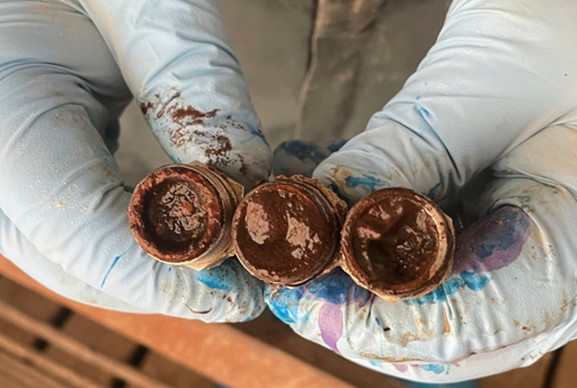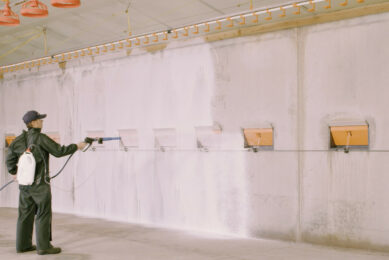Improved water line management in swine farms

Water line biology and water system management play crucial roles in improving pig livability. Effective water management enhances biosecurity and medication effectiveness, ultimately benefiting swine health.
Research indicates that water treatment reduces sow mortality related to pelvic organ prolapse, highlighting the need for further study. Water sources and biofilms in water lines pose biosecurity risks by harboring pathogens. Additionally, biofilms may impact the efficacy of water-administered medications through the spread of antimicrobial resistance genes.
Opportunities for improved water line management

Swine water systems are often non-circulating, low-pressure, and have multiple “open” points (medicators, filters, nipples, wet-to-dry feeders). Common water quality issues, such as water hardness and iron, create an ideal environment for biofilm growth, further influenced by water treatments like probiotics, electrolytes, and antimicrobial medications (Figure 1).
The presence of biofilm often goes unnoticed until significant problems arise, such as clogged water nipples, foul-smelling water, or persistent disease challenges like recurring E. coli infections.
Stock solution buckets
A potential major contamination point in water systems is the stock solution bucket, which supplies treatments to the medicator. These buckets are often reused without cleaning, leading to the accumulation of residues that can inactivate subsequent treatments (Figure 2).

Solutions include using disposable liners, keeping buckets covered, and cleaning medicators regularly to prevent biofilm buildup and cross-contamination.
Monitoring water quality
Water quality has traditionally been poorly monitored unless an issue arises. While pigs tolerate a range of water qualities, young pigs are more susceptible to water quality challenges, and modern pigs may have a lower tolerance for poor water conditions.
Monitoring water at multiple points within a farm is essential. A recent Iowa State University’s Swine Medicine Education Center study, conducted in collaboration with CID Lines, an Ecolab Company, found that coliform levels were higher at water samples taken inside barns compared to well water, indicating that water degrades due to biofilm shedding.
Coliforms may not always be pathogenic, but they indicate conditions that could support harmful microbes. Understanding water quality challenges – such as mineral content, and microbial presence – helps producers select appropriate treatments tailored to their farm’s specific needs.
Cleaning water lines
Regular water line cleaning is critical for maintaining a healthy water distribution system. The effectiveness of cleaning protocols varies depending on system design, water quality, and farm-specific factors. Research from Iowa State University’s Swine Medicine Education Center found that a one-time water line disinfection event using CID 2000 Pro significantly reduced biofilm loads initially, but biofilms were reestablished within 72 hours. This highlights the need for continuous disinfection strategies to prevent and manage regrowth.
Water quality and biofilm effects on medications
Ensuring effective medication administration is crucial for pig health. Water medication efficacy is influenced by water quality, biofilm presence, and proper dosing. Best practices for medication administration include:
- Using a clean stock solution bucket
- Replacing stock solutions every 12-24 hours
- Regularly mixing solutions to maintain proper suspension
- Ensuring correct dilution to achieve intended dosages
Studies show that improper water medication practices are common in swine farms, leading to increased costs, reduced antimicrobial efficacy, and potential antimicrobial resistance. Additionally, water quality factors – such as pH, hardness, and chlorine levels – can degrade medication stability and efficacy. Disinfectants, peroxides, and acids present in water can also reduce the effectiveness of oral vaccines.
Impact of biofilms on medications
Biofilms impact water medication effectiveness by providing a protective barrier against antimicrobials and facilitate antimicrobial resistance gene transfer, compounding the challenge of maintaining effective treatments.
Research from Swine Medicine Education Center found that swine farm water line biofilms contained antimicrobial resistance genes for multiple antibiotic classes, including aminoglycosides, quinolones, beta-lactams, and tetracyclines. Additionally, F18 E. coli was isolated from biofilms grown on drug-infused culture plates, demonstrating phenotypic resistance.
Eliminating and managing biofilms in water distribution systems is crucial for ensuring that antimicrobial treatments remain effective. Proper dosing, regular medicator maintenance, and ongoing water line disinfection are necessary to minimise potential biofilm-related medication interference.
Conclusion
Water line biology and best management practices remain generally underexplored in swine health and biosecurity. Water distribution systems may act as reservoirs for endemic swine pathogens, exposing a significant biosecurity gap.
Further research is needed to understand waterborne disease transmission, biofilm composition, antimicrobial resistance, and best management practices for effective water treatment strategies. Addressing these challenges will improve pig livability, enhance antimicrobial efficacy, and strengthen biosecurity in swine production.
References are available on request.



